The Modern Ferret Lifestyle
“Denise came to live with us when we moved from Athens, Greece, to Montana in the summer of 1980. Born in the stable of the renowned classical guitarist Christopher Parkening, Denise turned up for sale ($20) at Farmer’s Market in Bozeman. We’d never seen a little ferret kit before, and were enchanted by the tiny black-masked creature’s habit of hopping sideways while chattering happily, and awed by her ability to slip under doors like a furry snake.”—By Adrienne Mayor
Collected Curiosities
By Adrienne Mayor
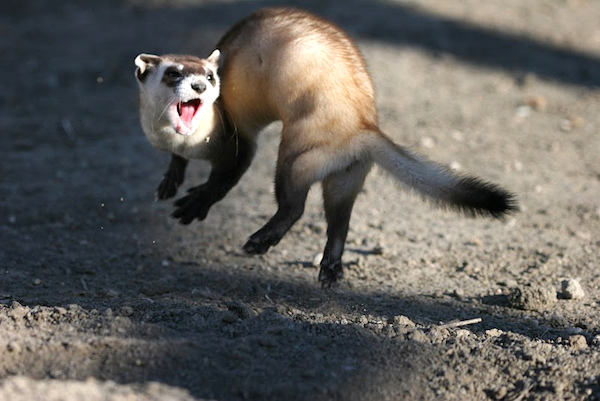
 STANFORD California—(Weekly Hubris)—May 2017—Denise came to live with us when we moved from Athens, Greece, to Montana in the summer of 1980. Born in the stable of the renowned classical guitarist Christopher Parkening, Denise turned up for sale ($20) at Farmer’s Market in Bozeman. We’d never seen a little ferret kit before, and were enchanted by the tiny black-masked creature’s habit of hopping sideways while chattering happily, and awed by her ability to slip under doors like a furry snake. Ferrets were virtually unknown in American households at this time, and I think Josh and I were among the first to have a ferret as a pet. We named her Denise, after the 1963 song by Randy and the Rainbows, covered in 1978 as “Denis” by the New Wave band Blondie, and crooned by Deborah Harry: “Denis, Denis/Oh Denis, scooby do,/I’m in love with you.”
STANFORD California—(Weekly Hubris)—May 2017—Denise came to live with us when we moved from Athens, Greece, to Montana in the summer of 1980. Born in the stable of the renowned classical guitarist Christopher Parkening, Denise turned up for sale ($20) at Farmer’s Market in Bozeman. We’d never seen a little ferret kit before, and were enchanted by the tiny black-masked creature’s habit of hopping sideways while chattering happily, and awed by her ability to slip under doors like a furry snake. Ferrets were virtually unknown in American households at this time, and I think Josh and I were among the first to have a ferret as a pet. We named her Denise, after the 1963 song by Randy and the Rainbows, covered in 1978 as “Denis” by the New Wave band Blondie, and crooned by Deborah Harry: “Denis, Denis/Oh Denis, scooby do,/I’m in love with you.”
Josh built a spacious wooden cage for her, with a sleeping loft and a beefcake photo of Arnold Schwarzenegger in his 1970s pumping-iron phase. Denise lovingly clawed his pin-up picture to shreds. For several hours a day, we let her scamper around the house, exploring, and sometimes leaving a few modest poop pellets in corners. We learned that close supervision was required: her slinky body and short legs could wriggle through knotholes in walls and incredibly small openings around pipes and wires, allowing her access to mysterious—and otherwise inaccessible—passageways of the house.
In Montana, we became avid flyfisherpeople, so Denise feasted on raw trout hearts fresh from the Yellowstone River. Her favorite treat was honey, licked from a spoon, eyes closed in ecstasy. Ferrets have a sweet tooth, a trait that proved indispensable in coaxing Denise out from behind furniture and under sinks when it was time to return to her cage. Honey also allowed manicures; just a dab on her tummy distracted her long enough to clip all 20 wolverine-sharp claws. Before we hit upon this method, Josh and I often sported bandaged fingers.
We learned that ferrets’ sharp teeth are much larger than those of domestic cats. Ferrets’ vise-like grip is infamous and, like many wild ferrets, Denise tended to bite when in doubt. Later, after owning four ferrets, we finally learned the secret of getting a biting ferret to release its jaws: since instinctively pulling away only tightens the grip, one must—against all reason—push one’s hand even farther into the razor-toothed maw to make the ferret let go. Moreover, unlike cats, which can play with their claws pulled in, ferrets are more like tiny grizzly bears, with wicked, non-retractable claws. Just the thing for burrowing after wild rabbits in warrens, but they do need trimming for playing with humans.
Like all ferrets, after a burst of manic energy—chirping in the distinctive happy chatter of polecats and stoats and performing wild dances of pure joy—Denise tended to take sudden naps, invariably totally flat, usually under a carpet. On several occasions when Denise was young, Josh and I were terrified she had perished in her sleep, but all ferrets sleep extremely soundly, going dead limp, mimicking a coma-like state. When they finally do emerge from sleep, they come back to life very slowly, yawning, blinking, and lolling about until fully alert. This bipolar feature of activity/deep sleep posed a great danger—we learned to look carefully wherever we stepped when she was out and about.
Until the mid-1990s, most US veterinarians were clueless about ferret care. Were ferrets canine or feline? Our Montana vet decided to give Denise all the routine shots for both cats and dogs, just to be safe. Should we feed her dog food or cat food? Denise preferred feline kibble, supplemented by raw beef and trout.
The first time young Denise went into heat, she became so weak she nearly died. At that time, no one understood that puberty could be fatal for female ferrets. Her puzzled vet said he could only recommend TLC. So we placed Denise on a heating pad and hand-fed her a simple gruel and honey water for ten days. To our great relief, she survived.
In the wild, ferrets have a short lifespan, at most three or four years. Fighting males defending territory often inflict fatal wounds on each other, and even the mating behavior of males and females is remarkably violent. Nature’s orders are shockingly cruel for Jills (female ferrets): “Mate or die!” A few years later, Denise’s doctor learned that Jills in heat who fail to mate may not survive the rigors of long-term, unsatisfied estrus. Since we did not plan on breeding ferrets, we opted to have Denise spayed, another learning experience for her vet. No one knew how long she would live in domesticity.
In the 1980s, second-home Californians and New Agers had not yet discovered Montana. Friends and family in other states were appalled that in our new home in the Rockies we were cosseting such a strange wild animal. Many assumed that Denise was a species of large rat, while others worried that we lived with a treacherous weasel, notorious for vicious sneak attacks.
Ferrets are not rodents but European polecats, in the mustelid family. Mustelids include weasels, minks, fisher cats, pine martens, badgers, and wolverines: a family of fierce, extremely strong for their size, determined alpha predators which hunt prey much larger than themselves. Oh, and mustelids do have a distinctive odor—Denise’s two-tone black and tan fur gave off a strong, musky-sweet scent. Like their cousins the skunks, both males and females release a powerful spray when startled or angry, though later we were made aware that the male version is about ten times more eye-watering than the female.
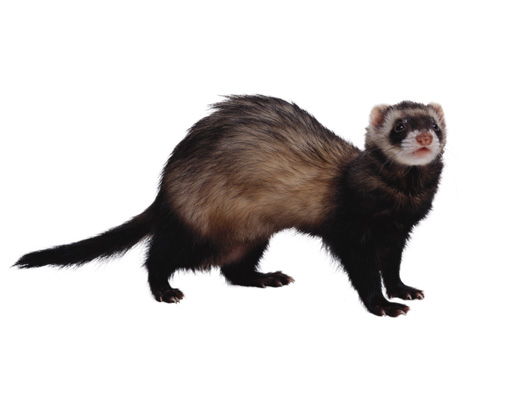
Sadly, ferrets do have a vicious reputation in folklore and literature, a result of their use in rabbit hunting in the British Isles, where ferrets were deliberately kept untamed by owners and not coddled as pets. Many dubious literary friends reminded us of the murderous fictional ferret named Shredni Vashtar in the short horror story of the same name by the witty and macabre Edwardian writer Saki. Others sent us descriptions of an obscure British endurance sport called “ferret-legging,” in which pub patrons bet on how long contestants can tolerate a pair of hungry ferrets scrabbling curiously inside a pair of belted, baggy woolen trousers with tight cuffs.
To counter our friends’ and relatives’ terror and to reveal the charms of our beloved Denise, we typed and mailed out an irregular series of newsletters titled “Denise’s Diary,” recounting her adventures and musings on life. Decades before the Internet and the Blogosphere, Denise was the first Ferret Blogger. Well traveled, she criss-crossed the country with us several times. In Minnesota, she learned to swim in my mother’s goldfish pond, and she escaped from a flimsy cardboard enclosure to surprise my father in the bathroom at midnight. In North Carolina, Denise was involved in setting a false fire alarm, as we tried to sneak her into a motel that frowned on pets of any kind. She lived in an outdoor cage filled with straw for a year as an illegal alien in New Hampshire (ferrets are banned by law in the state). In New Hampshire, Denise discovered maple syrup, fed to her by our 3-year-old niece Katy. Denise also accompanied us to Ann Arbor, Michigan, for a year. She was allowed to dwell in our apartment only because the landlady was under the false impression that we owned a “small caged creature something like a hamster.”
Denise enjoyed an adventure-filled life of seven years, double the span of her wild relatives. By the time we lost her, ferrets were beginning to enter American popular culture. Maybe Denise’s widely disseminated “Diary” played some small part in making ferrets more acceptable. In 1986, ferrets were declared “Pet of the Year” on the front page of the Wall Street Journal.
Missing Denise’s lively, fierce presence, in 1988 we found Spike, a male ferret with a gentle personality so different from Denise’s. White, fluffy, innocent-faced ferrets like Spike were often more “domesticated”—they made eye contact and rarely nipped. Ferrets like Denise, with black tails and legs, slender and sleek physiques, pointed noses, and raccoon-like black masks, more closely resembled their wild relatives, the nearly extinct black-footed ferret of the high prairies. Along with being more sneaky and feral in behavior, it’s fair to say that Denise and her kind also seemed more intelligent than the fluffy white cousins.
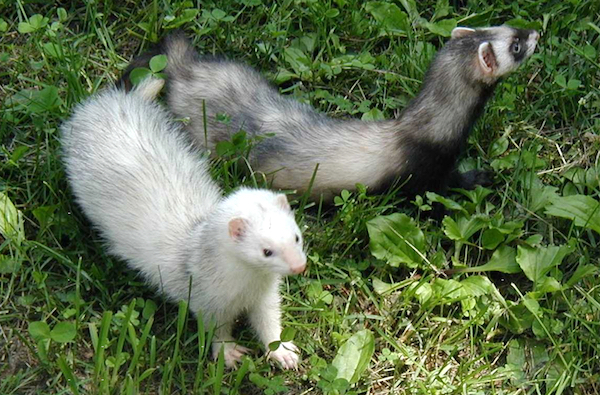
Like all ferrets, Spike was a thief, stealing anything he could drag with his powerful little jaws. He was attracted to houseguests’ wallets, scattering credit cards and cash under beds and dressers. And he often horrified visitors who witnessed him scuttling backwards into the dark recess under the sofa with his favorite toy: a cast-off naked Barbie doll.
Spike accompanied us when we moved to Princeton, NJ, in 1990. One day,our good friends Marcia and Ronna brought their very proper mother, visiting from Montreal, to tea. Mrs. M—well aware of the nefarious literary reputation of ferrets—was taken aback to find Shredni Vashtar’s cousin cavorting on the carpet next to the coffee table. Before we could stop him, Spike ran up her white linen trouser leg. Luckily, before he reached her knee, he was awkwardly extricated without snagging flesh or fabric. Profuse apologies were sincerely proffered. Mrs. M was quite gracious about this unannounced bout of ferret-legging, but she left the tea party as soon as good manners allowed.
Known for his unusually sweet disposition, Spike was also distinguished for his extra stinkiness. As noted, ferrets often release their musk glands when threatened or taken by surprise. Spike was especially sensitive. He was routinely startled upon simply awakening from an ordinary nap. Apparently, momentary disorientation caused him to immediately let loose a spray of overpowering polecat perfume, a stench especially intense in the close quarters of our car when we drove across the country between Montana and New Jersey. Rolling down the windows was the only recourse, even in winter. We take this opportunity to apologize to the countless toll-takers on the Pennsylvania, Ohio, Indiana, and Chicago Turnpikes who may still recall the skunky blast suddenly emanating from an otherwise normal-appearing car.
In 1993, Spike was featured in Life Blood, a best-selling mystery novel by the late Princeton writer Caroline Champlin, who had met him on many occasions in Princeton. In the novel, the fictional Spike helps a young boy to solve a murder in the Cotswolds.
The real Spike was utterly fearless, leaping from high places with all four short paws splayed, and he had a naïve, unbounded curiosity. We once searched for him for hours, finally detecting the sounds of his attempts to burrow out through a wall in the basement behind the laundry basket next to the washing machine. He had slid down the space behind an old-fashioned laundry chute on the first floor and landed in a sealed-off space in the basement. He had to be rescued through careful carpentry, because while we drilled and sawed an opening in the wall big enough for his escape, he was also trying to help enlarge the hole from the other side. As soon as he was released from the trap, the intrepid creature bounded up the stairs and attempted to slide down the same hatch to the basement again.
Spike had other, more sensual pleasures. On the long road trips back and forth from our new home in Princeton, where Josh taught Classics, back to our old place in Montana each summer, we chose lodgings that accepted pets. Spike was enamored of 1950s mom-and-pop motels equipped with shag carpets and those Magic Fingers vibrating beds. I will never forget the sight of a fluffy white ball of fur chattering and skittering like a mad thing across the shaggy rug and bouncing on the vibrating chenille bedspread. Wherever we traveled together, Spike’s unexpected habit of licking the hands of friends and strangers alike endeared him to everyone who met him.
The next year, we went abroad, and were compelled to leave Spike in the care of our house sitter, a serious Brahmin philosopher from India, Professor Arindam C. We hoped that Spike’s delightful personality and vague physical resemblance to a mongoose might facilitate their relationship. Professor C assured us that he and his charge got along famously.
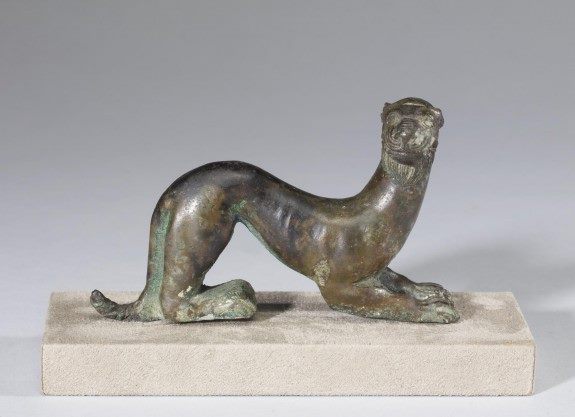
Denise and Spike inspired me to delve into the history of ferrets, weasels, polecats, and ermines. I learned that domestic ferrets were featured in ancient Greek myths and comedies, and depicted at play on Greek vase paintings and Roman frescoes. Long before cats became available outside of Egypt (as sacred animals, cats were not permitted to be exported), Greeks and Romans prized ferrets as mousers and pets. My article “Grecian Weasels,” tracing the ancient history of ferret domestication, was published in Greece’s English-language magazine, The Athenian, in 1989, and dedicated to Spike and Denise.
Josh and I admired Leonardo da Vinci’s portrait of a girl with her tame “ermine,” and learned that ferrets were pets in the Middle Ages and Renaissance. Fitches—ferrets—were raised for their fur and rabbit hunting in nineteenth century America (as the many towns named “Fitchburg” attest).
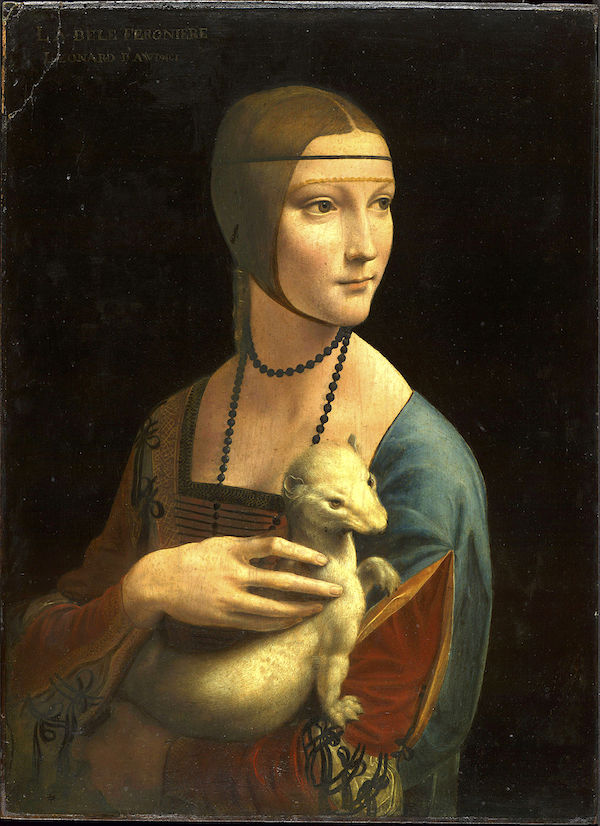
Yet, in the United States, ferrets are outlawed in Manhattan, California, New Hampshire, and other locales, labeled as “dangerous, undomesticated wildlife.” In 1999, we heard Rudolf Giuliani, then mayor of New York City, deliver his infamous “ferret rant” on the radio, comparing ferrets to “wild tigers,” and advising psychiatric interventions for “crazy weasel-lovers.” Ferret owners responded with ferret rallies in Central Park, and Modern Ferret: The Ferret Lifestyle Magazine was founded in New York in protest.
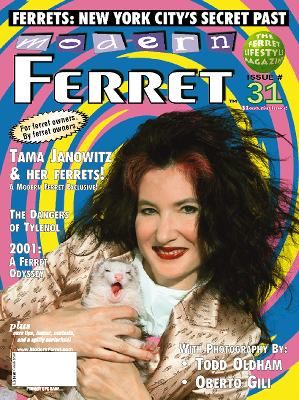
Spike in old age suffered from low blood sugar, for which his vet prescribed a dab of honey, his favorite treat. He passed away at age eight and is buried in our backyard in Bozeman, Montana, his birthplace.
Back in Princeton, missing Spike, in 1996 we decided to double the fun with twin ferret kits. We named the sisters Blanche and Stella. They loved to chase each other, chuckling wildly, creating a maze of tunnels underneath our Turkish carpets.The twins had wildly different personalities: Blanche, fluffy, white, and chubby like Spike, also had his trusting, innocent personality. Her sister, the lean, black-masked Stella, was more feral, like Denise. Stella’s first impulse was to bite and never let go. Stella could be vindictive, too, especially when we retrieved the TV remotes that she stole and hid under the couch. To get even, she would sneak up behind whoever had grabbed her treasure and sink her sharp incisors into the ankle. Yet, as we gazed at Stella and Blanche sleeping cozily together in their blue-striped hammock, we knew we loved them equally.
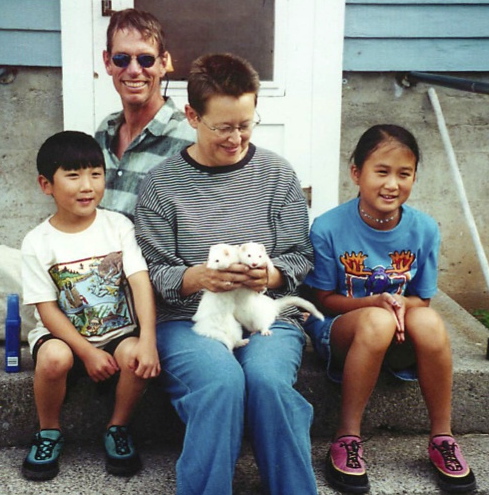
Like Spike, Stella and Blanche also traveled by car back and forth from Montana to Princeton each summer. Though Magic Fingers vibrating beds had disappeared from motels, the twins enjoyed squirming up inside the box springs of mattresses, and there they remained until our departures—delayed until honey could be procured.
During our time in Princeton, we often entertained with dinners for eight. Sometimes, after dessert, guests in devil-may-care moods or out of genuine curiosity, would ask to meet Stella and Blanche. We were reluctant, since people who have indulged in wine and a pair of exuberant, wriggling ferrets can create a dynamic difficult to control but all too easy to predict. Sometimes we would comply, however, and privileged guests were treated to the charming spectacle—and true peril—of excited, clumsy little furry creatures frolicking up and down the table among the goblets, candlesticks, silverware, and fruit and cheese rinds. Blanche never nipped, but Stella always did. We warned our guests not to extend fingers or try to pet Stella–but it was not easy to tell the twins apart by candlelight. Sometimes the evening ended calmly, but other times, chaos threatened and Josh would scoop up the ferrets and put them away. Then Band-Aids—considered badges of honor by colleagues and graduate students—were dispensed, as Blanche and Stella snuggled peacefully into their hammock.
Stella lived to the ripe old age of nine and a half, and her companion Blanche died a month later. They are recalled fondly by all who were lucky enough to attend their legendary dinner parties in staid old Princeton.
After two decades of living the 20th-century “modern ferret lifestyle” with Denise, Spike, Stella, and Blanche, for the new millennium we welcomed a different sort of exotic creature into our lives. We found our Bengal kitten named Bindi, with soft, spotted fur like the Asian Leopard Cats he is descended from, on a ranch in Montana, the home of two wildlife biologists. They had weaned Bindi and his siblings from their mother’s milk to raw meat from their own bison herd. Our beloved Bindi (“spot” or “dot” in Hindi) was a piece of work, filling our lives with joyful aggravation in a hundred different ways. But that’s another story.
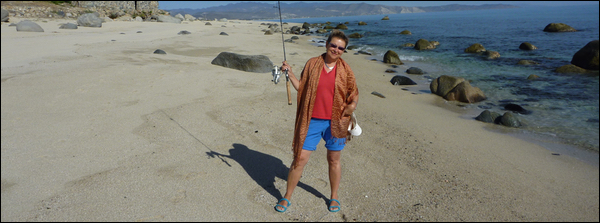
One Comment
Kristin Armstrong
I just loved your article about your adventures with ferrets. I too am a ferret mom and absolutely have fallen in love with these creatures. Growing up I only had cats and dogs. Un my early 40s I started developing anxiety, living in a very small studio apartment I gave up on having a comfort animal as most were dogs. My fiance suggested we get a ferret. So off we went and brought home Sarah. 3 months later after I researched and studied hard about ferrets we brought home Emma. 3 weeks later came Lilly. Ferret math is a real thing…lol I am very happy to say that my anxiety is gone and in its place are 3 adorable fuzz butts who have became family…